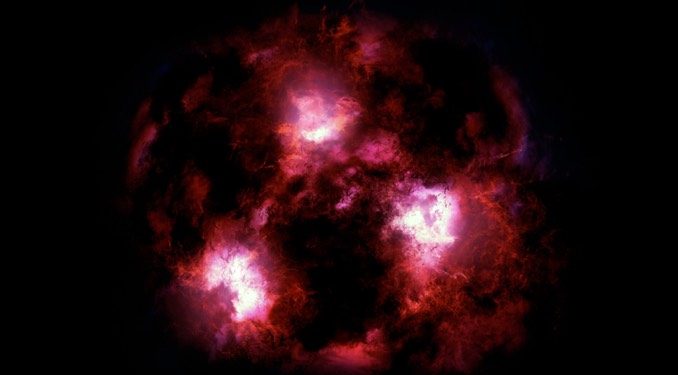
Astronomers have chanced upon evidence for a surprisingly large galaxy lurking 12.5 billion light years away behind vast clouds of dust in the early Universe, forming new stars a hundred times faster than the Milky Way. The galaxy may represent a missing link of sorts, helping astronomers figure how how stars came together in the infant Universe to form huge galaxies on relatively short timescales.
“Our hidden monster galaxy has precisely the right ingredients to be that missing link, because they are probably a lot more common,” said University of Arizona astronomer Christina Williams, lead author of a study published in The Astrophysical Journal.
The galaxy in question cannot be directly seen, but the heat produced by its stars warms the obscuring dust enough to produce a faint glow, detected by the antennas making up the Atacama Large Millimeter/submillimeter Array in Chile.
“It was very mysterious because the light seemed not to be linked to any known galaxy at all,” said Williams. “When I saw this galaxy was invisible at any other wavelength, I got really excited because it meant that it was probably really far away and hidden by clouds of dust.”
Co-author Ivo Labbé, a researcher at the Swinburne University of Technology in Melbourne, Australia, said the young galaxy hosts as many stars as the Milky Way but “brimming with activity, forming new stars at 100 times the rate of our own galaxy.”
A major question in galactic evolution is how large, seemingly mature galaxies quickly form in the aftermath of the big bang. Such galaxies can be seen when the Universe was 10 percent its current age, but finding the intermediate steps – catching galaxies in the act of forming – has been difficult.
A major question is how common galaxies like the one spotted by Williams and her colleagues might be. Because the observation was made in an area of the sky less than 1/100th the size of the full moon, the find was either a matter of pure luck or evidence such galaxies are virtually everywhere.
Williams said the James Webb Space Telescope “will be able to look through the dust veil so we can learn how big these galaxies really are and how fast they are growing, to better understand why models fail in explaining them.”



